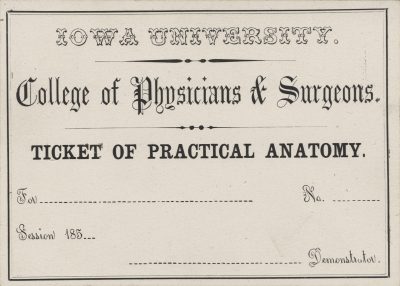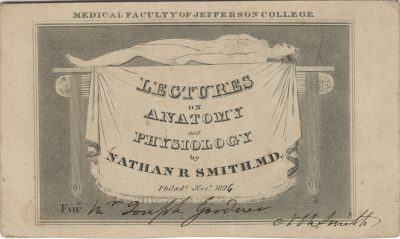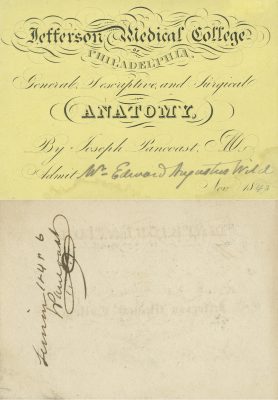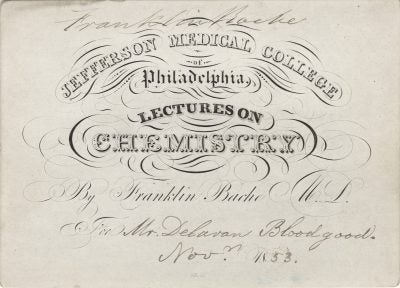27. Infirmary for the Relief of the Ruptured Poor (discontinued)
| Infirmary for the Relief of the Ruptured Poor (discontinued) c1840 Chase, Heber, MD and Coates, Reynell, MD Carpenter, Henry Hospital privileges |
|
| In Philadelphia in 1838 Chase (Penn; M1836) opened the Infirmary for the Relief of the Ruptured Poor, literally to treat cases of hernia that were prevalent among the city’s laborers. Chase previously had designed instruments for treating herniae, which the American Journal of Science had reported on. For a fee, Chase and Coates welcomed medical students to the Infirmary and their lectures to further their clinical training. Coates (Penn; M1823) had apprenticed with Benjamin Rush, MD (12) and served as a Navy surgeon. With his brother and two other physicians, he established the Philadelphia Medical Academy, another of the city’s extramural resources for medical education, where he lectured on the daily duties of the surgeon. Coates authored Popular Medicine or Family Adviser, founded the Patriotic Order Sons of America, and in the 1852 national election ran for vice-president on the Native American Party ticket with Daniel Webster for president.
Chase, Heber. The Medical Student’s Guide: Being a Compendious View of the Collegiate and Clinical Medical Schools, the Courses of Private Lectures, the Hospitals and Almshouses, and Other Institutions which Contribute Directly or Indirectly to the Great Medical School of Philadelphia; With the Regulations of Hours, Fees, &c. and Other Information of Importance to Students. Phila: J.G. Auner, 1842. 33.
Kelly, Howard A. and Walter L. Burrage. American Medical Biographies. Baltimore: The Norman Remington Company, 1920. 231. “Reynell Coates.” Wikepedia. http://en.wikipedia.org/wiki/Reynell_Coates |
|
28. Iowa University College of Physicians and Surgeons (University of Iowa Carver College of Medicine)
| Iowa University College of Physicians and Surgeons (University of Iowa Carver College of Medicine) 185_ n/a n/a Anatomy |
|
|
In 1849 The College of Physicians and Surgeons of the Upper Mississippi (Davenport, Iowa) opened as a proprietary medical school. It moved to Keokuk in 1850, and from 1851 to 1868 the State University of Iowa recognized the school as its Medical Department. That affiliation ended when a medical school opened in Iowa City, location of the State University. The College of Physicians and Surgeons continued to operate as an independent institution. Through a series of mergers it melded into the State University of Iowa in 1913. The blank anatomy ticket for 185_ reflects a story of destiny. On the opening eve of the 1851 session, Professor of Anatomy Nichols Hard, MD died of cholera. The dean, who was in NY at the time, offered Elias Cooper, MD of Peoria the position. The school’s board rescinded the offer on grounds that only the president could appoint Hard’s successor. The offer never went to Cooper a second time. He headed west to San Francisco and founded the Medical College of the Pacific, forerunner of Stanford University School of Medicine.
Lawrence, Susan C. “Iowa Physicians: Legitimacy, Institutions, and the Practice of Medicine, Part One: Establishing a Professional Identity, 1833-1886” (2004). Faculty Publications, Department of History. Paper 40. http://digitalcommons.unl.edu/historyfacpub/40
__________. “Iowa Physicians: Legitimacy, Institutions, and the Practice of Medicine, Part Two: Putting Science into Practice, 1887-1928” (2004). Faculty Publications, Department of History. Paper 42. http://digitalcommons.unl.edu/historyfacpub/42 Wilson, John Long. “Stanford University School of Medicine and the Predecessor Schools: An Historical Perspective.” Lane Archives, Stanford University. |
|
29. Jefferson Medical College
| Jefferson Medical College 1826 Smith, Nathan R., MD Goodwin, Joseph Anatomy and physiology |
|
|
Smith (Yale; M1823) was one of the original faculty members when Jefferson Medical College opened its first course of lectures in November 1825. Earlier that year Smith had attended lectures at Penn, where he met Jefferson founder George McClellan, MD (51), who recruited him to teach anatomy at the new medical school. Hailing from New Hampshire and being without Philadelphia connections to build his practice, Smith found he could not sustain himself on lecture fees. After two years at Jefferson, the University of Maryland fortuitously offered him the chair of anatomy, and eventually surgery. Smith spent 50 years on the Maryland medical faculty. Goodwin does not appear to have graduated from Jefferson, although he was among the new medical school’s earliest students to purchase lecture tickets.
Kelly, Howard A. and Walter L. Burrage. American Medical Biographies. Baltimore: The Norman Remington Company, 1920. 1076-77.
|
|
30. Jefferson Medical College
| Jefferson Medical College 1845 Pancoast, Joseph, MD Wild, Edward Augustus Anatomy |
|
|
Pancoast (Penn; M1828) joined the Jefferson faculty as professor of surgery in 1838. By 1845 he taught anatomy yet led a prolific career as a surgical innovator and contributor to medical literature. Among his diverse surgical innovations, Pancoast devised a new operation for soft and mixed cataracts, developed plow and groove or plastic sutures for rhinoplastic operations, and originated the abdominal tourniquet to prevent death by blood loss during amputations at the hip or upper thigh. (For Wild, see 23.)
JAMA 1967;201(13):1042.
Kelly, Howard A. and Walter L. Burrage. American Medical Biographies. Baltimore: The Norman Remington Company, 1920. 879-80. |
|
31. Jefferson Medical College
| Jefferson Medical College 1845 Mitchell, John K., MD Wild, Edward Augustus Practice of medicine |
|
| Mitchell (Penn; M1819), a chemist and physician, spent the early part of his career lecturing on the institutes of medicine and physiology, as well as chemistry, at the Medical Institute of Philadelphia (36). In 1841 he became Jefferson’s chair of theory and practice of medicine. Mitchell wrote on a variety of topics including mesmerism, osmosis and liquefaction of carbonic acid gas, and the ligature of limbs in spastic conditions. In 1831 he became the first to describe spinal arthropathies. His other notable medical works include a treatise, On the Crytogamous Origin of Malarious and Epidemical Fevers (1849). (For Wild, see 23.)
Kelly, Howard A. and Walter L. Burrage. American Medical Biographies. Baltimore: The Norman Remington Company, 1920. 801-02.
|
|
32. Jefferson Medical College
| Jefferson Medical College 1853 Bache, Franklin, MD Bloodgood, Delavan Chemistry |
|
| Bache, great-grandson of Benjamin Franklin and private pupil of Benjamin Rush, MD (12), received a Penn medical degree in 1814. He served as a surgeon in the War of 1812 and afterward supported himself treating recruits and military men, and lecturing on chemistry to private pupils of a physician/preceptor. Bache served as physician to Walnut Street Prison and Eastern State Penitentiary. He lectured on chemistry at the Franklin Institute, the Philadelphia College of Pharmacology and a private medical school called the Association for Medical Instruction before Jefferson offered him the Professorship of Chemistry in 1841. With George B. Wood, MD (85) Bache authored Dispensatory of the U.S. (1833), reprinted in more than 20 editions and used well into the 20th century. Bloodgood (Jefferson; M1854) started his 36-year Navy career in 1857. He rose from assistant surgeon to medical director of the Naval Laboratory in Brooklyn, NY. He served in the Civil War and came out of retirement for duty during the Spanish-American War.
Kelly, Howard A. and Walter L. Burrage. American Medical Biographies. Baltimore: The Norman Remington Company, 1920. 50.
Obituary of Dr. Delavan Bloodgood. New York Times. April 6, 1902. Wood, George B. Biographical Memoir of Franklin Bache, MD. Phila: J.B. Lippincott & Co., 1865. |
|
33. Kentucky School of Medicine (University of Louisville School of Medicine)
| Kentucky School of Medicine (University of Louisville School of Medicine) 1856-57 Bullitt, Henry M., MD (dean) Haymaker, George W. Physiology and pathology |
|
| At a time when the mid-19th-century American “West” was growing, the Kentucky School of Medicine opened in Louisville in 1850 as the Medical Department of Masonic University. Medical faculty from Transylvania University (57), which was experiencing its decline, founded the new school. Students had access to the Louisville Marine Hospital (34) alongside University of Louisville (62) medical students. In 1908 the Kentucky School of Medicine merged into the University of Louisville Medical Department. Bullitt (Penn; M1838), professor of materia medica and botany at Transylvania University, spearheaded the organization of the Kentucky School of Medicine and served as its first dean. In 1866 he chaired principles and practice of medicine and then physiology at the University of Louisville, and in 1868 established the Louisville Medical College. He also served as Louisville’s first health officer. Haymaker graduated from Kentucky in 1857.
Kelly, Howard A. and Walter L. Burrage. American Medical Biographies. Baltimore: The Norman Remington Company, 1920. 170.
Norwood, William Frederick. Medical Education in the United States before the Civil War. Phila: University of Pennsylvania Press, 1944. 301-03. |
|
34. Louisville Marine Hospital
|
Louisville Marine Hospital 1856-57 Palmer, B.R., MD (dean) Haymaker, George W. Clinical medicine and surgery |
|
|
In 1837 Congress authorized the Louisville Marine Hospital “for the benefit of sick seamen, boatmen, and other navigators on the western rivers and lakes.” Occupational hazards of injury and disease abounded. Initially 20 cents a month was deducted from each worker’s pay toward healthcare – the first example of pre-paid health insurance in American history. Robert Mills, architect of the Washington Monument and other major landmarks, designed the hospital building, which is listed as a National Historic Landmark. In 1852 the hospital opened for patient care, and at the same time, supplemented the clinical education of Kentucky School of Medicine students. In 1908 the University of Louisville absorbed the Kentucky School of Medicine. Haymaker attended clinical lectures at the Louisville Marine Hospital while matriculated at the Kentucky School of Medicine (M1857).
Lewis, Alvin Fayette. History of Higher Education in Kentucky. Washington, DC: Government Printing Office, 1899. 96-99.
U.S. Marine Hospital: A National Historic Landmark in Louisville, Kentucky. http://www.marinehospital.org/past.htm |
|








